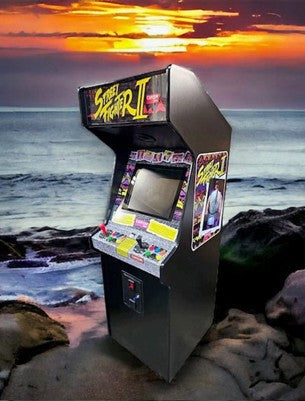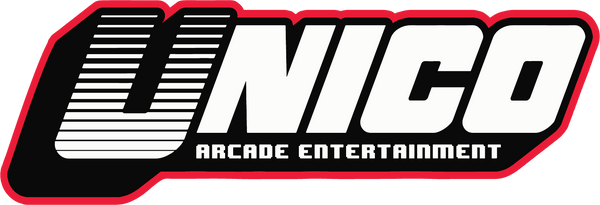
Celebrating the Legacy of Capcom's CPS-2: A Deep Dive into Retro Gaming with Unico's Nova Blast Candy Cab
At Unico we are all about arcades and retro gaming, we live it breathe it and at the heart of that history is Capcom with their revolutionary hardware, the CPS-2. These look amazing and work wonderfully with our Unico Nova Blast Candy Cab aka Unico Full Metal Candy.


The Capcom Play System 2 (CPS-2) is an iconic arcade system board developed by Capcom, launched in 1993 as a successor to the original CP System (CPS-1) and CP System Dash. It became a cornerstone of the 1990s arcade scene, particularly known for powering some of the most beloved 2D fighting games, beat 'em ups, and shooters. Below is a detailed history of the CPS-2, its significance, technical aspects, and legacy.
History of the CPS-2
Development and Launch (1990–1993)
Capcom announced the development of the CPS-2 in 1990, aiming to address the limitations of the CPS-1, particularly its vulnerability to bootlegging. The CPS-1, while successful with hits like Street Fighter II (1991), suffered from rampant piracy, with unauthorized copies like Street Fighter II: Rainbow Edition flooding arcades. Capcom invested in creating a more secure system with enhanced graphics and sound capabilities. The CPS-2 was released on September 10, 1993, with Super Street Fighter II as its debut title.
Capcom CPS2 Super Street Fighter II


The CPS-2 was designed to maintain Capcom’s dominance in arcades while combating piracy through encrypted ROMs and a “suicide battery” system, which tied game functionality to a battery-backed decryption key. This made unauthorized copying nearly impossible until the encryption was cracked years later.
Technical Advancements
The CPS-2 improved on the CPS-1 in several ways:
· Hardware: It used a Motorola 68000 CPU at 16 MHz for the main processing and a Z80 at 8 MHz for sound, paired with a QSound chip for 16-channel stereo audio, delivering richer soundscapes.
· Graphics: The system supported a 32-bit color palette with 4,096 on-screen colors, 16 colors per tile (4 bits per pixel), and up to 900 16x16 pixel sprites, enabling smoother animations and more detailed visuals. The resolution was 384x224 pixels.
· Modular Design: Like the CPS-1, the CPS-2 consisted of two boards: the
· A-Board (motherboard, connecting to the JAMMA harness with shared components) and the B-Board (game-specific ROMs). Both were encased in protective plastic shells to prevent dust, static damage, and tampering, with region-specific color coding (e.g., Blue for USA/Europe, Green for Japan, Grey for Asia, Orange for South America, Yellow for rentals).
· Anti-Piracy Measures: The CPS-2 employed heavy encryption on program ROMs, with decryption keys stored in battery-backed memory. If the battery (typically lasting 4–6 years) died or was tampered with, the game became unplayable, earning the nickname “suicide battery.”
Game Library and Impact (1993–2003)
The CPS-2 powered 41 games, with a focus on fighting games but also including beat 'em ups, shooters, and puzzle games. Its library is considered one of the most impressive in arcade history, rivaling SNK’s Neo Geo MVS. Notable titles include:
· Fighting Games: Super Street Fighter II (1993), Super Street Fighter II Turbo (1994), Street Fighter Alpha series (1995–1998), Darkstalkers series (1994–1997), X-Men: Children of the Atom (1994), Marvel vs. Capcom (1998), Street Fighter Alpha 3 (1998).
· Beat 'em Ups: Alien vs. Predator (1994), Armored Warriors (1994), Battle Circuit (1997), Dungeons & Dragons: Tower of Doom (1993), Dungeons & Dragons: Shadow over Mystara (1996).
· Shooters: 19XX: The War Against Destiny (1995), Giga Wing (1999), Progear (2001, developed by Cave).
· Puzzle Games: Super Puzzle Fighter II Turbo (1996).
The CPS-2 dominated arcades from 1993 to the late 1990s, particularly in the fighting game community, with titles like Super Street Fighter II Turbo and Street Fighter Alpha 3 setting standards for competitive play. Its vibrant sprites, smooth animations, and iconic soundtracks (thanks to QSound) made it a favorite among players and collectors.
Image Reference: Screenshots of Super Street Fighter II Turbo, Street Fighter Alpha 3, or Alien vs. Predator are widely available on UVList.net or Capcom.Fandom.com. These showcase the CPS-2’s vibrant 2D graphics, with large, detailed sprites and colorful backgrounds (e.g., Ryu’s stage in Street Fighter Alpha).
Piracy and the “Suicide Battery” Challenge
The CPS-2’s encryption was highly effective, preventing bootlegs until 2001 when the CPS-2 Shock group reverse-engineered the system, releasing XOR difference tables to enable emulation and restore “suicided” boards. In 2007, Andreas Naive and Nicola Salmoria fully cracked the encryption algorithm (two four-round Feistel ciphers with a 64-bit key), integrating it into MAME. By 2016, Eduardo Cruz, Artemio Urbina, and Ian Court developed a “de-suicide” method, allowing dead boards to be revived without hardware modifications, a process called “Phoenixing.”
The suicide battery remains a hurdle for collectors, as boards become unplayable if the battery drops below 2V. Replacing the battery before failure is critical, and collectors often turn to services like ArcadeHacker.blogspot.com for revival techniques.
Decline and Legacy (1996–2019)
The CPS-2 was succeeded by the CPS-3 in 1996, which used CDs and offered superior sprite scaling but saw only six releases (e.g., Street Fighter III). The CPS-2 outlasted its successor, with new releases until Hyper Street Fighter II in 2003. Capcom ceased manufacturing CPS-2 hardware in 2003 and ended technical support in 2015, with final support ending February 28, 2019.
The CPS-2’s legacy is immense. It defined the golden age of 2D arcade gaming, particularly fighting games, and its titles remain staples in retro arcades and esports tournaments. Many games were ported to consoles like the Sega Saturn, Dreamcast, PlayStation, and later as digital downloads on PSN and Xbox Live Arcade. However, rare titles like Alien vs. Predator and Progear remain unported, making original B-Boards highly sought after, with prices rising significantly (e.g., Marvel vs. Capcom boards fetching $500–$995 in 1999).
Collectors value CPS-2 boards for their durability (when maintained) and arcade-perfect experience. Systems like the UD-CPS2, a modern console adapter, and multi-game flash carts have kept the platform alive for enthusiasts.
Key Milestones
· 1990: CPS-2 development announced, targeting piracy issues and 3D graphics (later abandoned).
· 1993: CPS-2 launches with Super Street Fighter II.
· 2001: CPS-2 Shock group cracks encryption, enabling emulation.
· 2007: Encryption fully reverse-engineered by Andreas Naive and Nicola Salmoria.
· 2016: “De-suicide” method developed, preserving dead boards.
· 2003: Final CPS-2 game, Hyper Street Fighter II, released.
· 2019: Technical support ends.
Conclusion
The CPS-2 was a technological and cultural milestone, powering Capcom’s most iconic arcade games and shaping the fighting game genre. Its anti-piracy measures, while innovative, created challenges for preservation, but the community’s efforts have kept the platform alive
Thanks for taking a moment to share time with us and learning more about what makes your favorite arcade video games tick. Look out for our next installment soon. Have a great time gaming from us here at Unico. Pick up your Unico Nova Blast Candy Cab today and experience an all-in-one gaming experience solution from Novice to Pro.
https://www.unico-usa.com/collections/nova-blast-1
